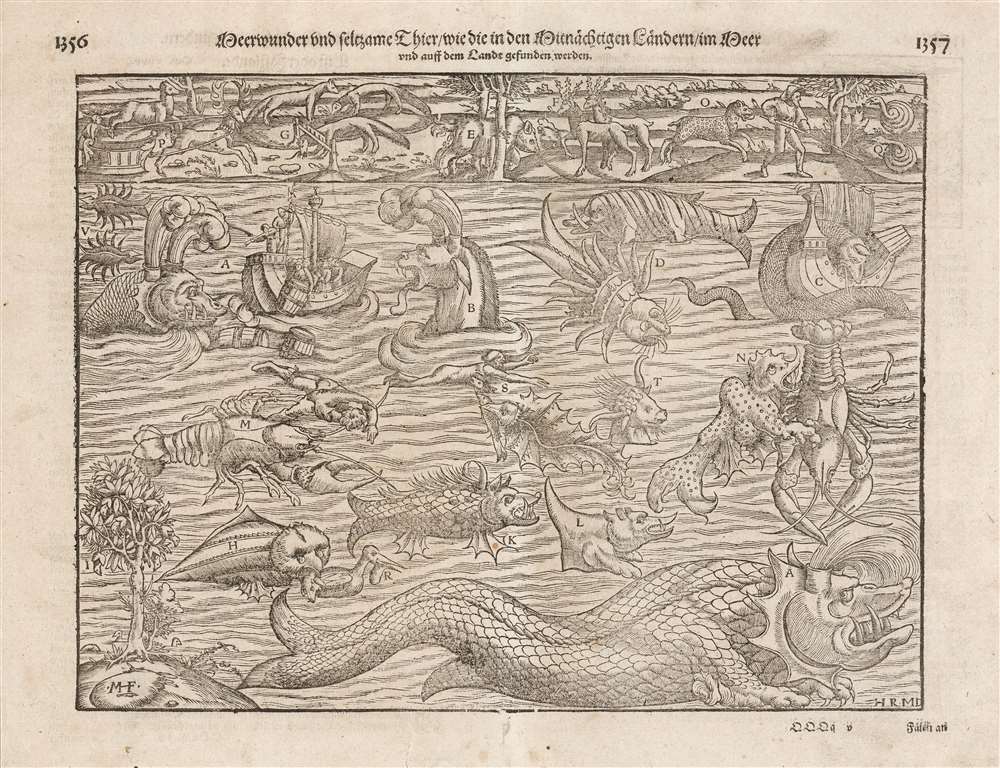This item has been sold, but you can get on the Waitlist to be notified if another example becomes available, or purchase a digital scan.
1614 Munster Map of Sea Monsters and Fantastical Beasts
MunstersMonsters-munster-1614
Title
1614 (undated) 12 x 14.5 in (30.48 x 36.83 cm)
Description
Among the more recognizable beasts are various forms of whales with obvious blowholes, at least two enormous lobsters, a sea serpent (probably an oarfish), the whale fish (white fish at center, an Orca), and something that might very well be a walrus. Of course, there are fictional sea monsters too, including a pig faced sea beast, apparently seen by sailors in 1537, and the Sea Buffalo, something that looks like a cross between a bull and a fish.
Although much is made of Munster's sea creatures, it should be noted that his map also illustrates land based fauna, most of which are far more realistic. These include reindeer, beavers, sables, bears, a wolverine, snakes, and what might be some sort of large cat. In the lower left, there is a tree populated by 'duckbirds,' a curious kind of avian that Munster claims 'grows on trees' but which, in his lifetime, had not been seen for some 400 years.
Although not properly a map, Munster included this catalog of beasts in his Cosmographia to illustrate the natural world. Today we might look at a book like the Cosmographia and consider it an atlas for its many maps, but the work itself is more accurately an attempt to describe, as the name suggests, the entire cosmos. It included descriptions of flora, fauna, geological and astronomical observations, historical notes, and cultural (some might even say anthropological) commentary.
Publication History and Census
Munster's Cosmographia was a popular work, and as many as fifty thousand were printed. While many of these did not survive, individual maps do appear on the market from time to time. The separate woodcut is neglected in institutional collections, although the full work is well represented in institutional collections. The typography of this specific example is consistent with the 1614 German edition of Cosmographey.CartographerS
Sebastian Münster (January 20, 1488 - May 26, 1552), was a German cartographer, cosmographer, Hebrew scholar and humanist. He was born at Ingelheim near Mainz, the son of Andreas Munster. He completed his studies at the Eberhard-Karls-Universität Tübingen in 1518, after which he was appointed to the University of Basel in 1527. As Professor of Hebrew, he edited the Hebrew Bible, accompanied by a Latin translation. In 1540 he published a Latin edition of Ptolemy's Geographia, which presented the ancient cartographer's 2nd century geographical data supplemented systematically with maps of the modern world. This was followed by what can be considered his principal work, the Cosmographia. First issued in 1544, this was the earliest German description of the modern world. It would become the go-to book for any literate layperson who wished to know about anywhere that was further than a day's journey from home. In preparation for his work on Cosmographia, Münster reached out to humanists around Europe and especially within the Holy Roman Empire, enlisting colleagues to provide him with up-to-date maps and views of their countries and cities, with the result that the book contains a disproportionate number of maps providing the first modern depictions of the areas they depict. Münster, as a religious man, was not producing a travel guide. Just as his work in ancient languages was intended to provide his students with as direct a connection as possible to scriptural revelation, his object in producing Cosmographia was to provide the reader with a description of all of creation: a further means of gaining revelation. The book, unsurprisingly, proved popular and was reissued in numerous editions and languages including Latin, French, Italian, and Czech. The last German edition was published in 1628, long after Münster's death of the plague in 1552. Cosmographia was one of the most successful and popular books of the 16th century, passing through 24 editions between 1544 and 1628. This success was due in part to its fascinating woodcuts (some by Hans Holbein the Younger, Urs Graf, Hans Rudolph Manuel Deutsch, and David Kandel). Münster's work was highly influential in reviving classical geography in 16th century Europe, and providing the intellectual foundations for the production of later compilations of cartographic work, such as Ortelius' Theatrum Orbis Terrarum Münster's output includes a small format 1536 map of Europe; the 1532 Grynaeus map of the world is also attributed to him. His non-geographical output includes Dictionarium trilingue in Latin, Greek, and Hebrew, and his 1537 Hebrew Gospel of Matthew. Most of Munster's work was published by his stepson, Heinrich Petri (Henricus Petrus), and his son Sebastian Henric Petri. More by this mapmaker...
Hans Rudolf Manuel Deutsch (1525–1571) was a Swiss artist and woodcutter. His work appeared in Agricola's De re metallica and for Sebastian Münster's Cosmographia. Deutsch's father, Niklaus Manuel Deutsch (the Elder) and his brother Niklaus were also artists. Learn More...

